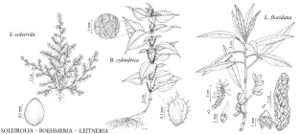Difference between revisions of "Leitneriaceae"
FNA>Volume Importer |
imported>Volume Importer |
||
| (5 intermediate revisions by 2 users not shown) | |||
| Line 51: | Line 51: | ||
|family=Leitneriaceae | |family=Leitneriaceae | ||
|illustrator=John Myers | |illustrator=John Myers | ||
| + | |illustration copyright=Flora of North America Association | ||
|distribution=se United States. | |distribution=se United States. | ||
|reference=abbe1940a;channell1962a;giannasi1986a;jarvis1989a;petersen1983b | |reference=abbe1940a;channell1962a;giannasi1986a;jarvis1989a;petersen1983b | ||
| Line 56: | Line 57: | ||
|publication year= | |publication year= | ||
|special status= | |special status= | ||
| − | |source xml=https:// | + | |source xml=https://bitbucket.org/aafc-mbb/fna-data-curation/src/2e0870ddd59836b60bcf96646a41e87ea5a5943a/coarse_grained_fna_xml/V3/V3_567.xml |
}}<!-- | }}<!-- | ||
-->[[Category:Treatment]] | -->[[Category:Treatment]] | ||
Latest revision as of 21:49, 5 November 2020
Shrubs or small trees. Wood white to yellowish, soft, brittle, even-grained; secretory canals in outer pith; resin yellowish. Leaves alternate, not aromatic; stipules absent; petiole and veins with secretory canals. Inflorescences axillary catkins, erect or lax. Flowers unisexual, staminate and pistillate on different (rarely on same) plants, inconspicuous, sessile; perianth absent or of small, undifferentiated sepals, hypogynous; pistils simple (rarely compound), 1(-2)-carpellate; ovary superior; placentation parietal; ovule 1, pendulous; style 1. Fruits drupes, leathery, dry.
Distribution
se United States.
Discussion
Genus 1, species 1.
Leitneriaceae are a relict family confined to the flora area and occurring on coastal and riverine flood plains of the Atlantic and Gulf coasts. The fossil record of the family extends to the Middle Oligocene (32-30 M.Y.B.P.).
Taxonomic affinities are uncertain. Various alliances have been suggested: Hamamelidales (A. Cronquist 1981), Sapindales (R. M. T. Dahlgren 1980), and Rutales (R. F. Thorne 1983) of the Rutiflorae. Biochemical studies (D. E. Giannasi 1986; F. P. Petersen and D. E. Fairbrothers 1983, 1985) suggest affinities with Simaroubaceae in Rutales.
